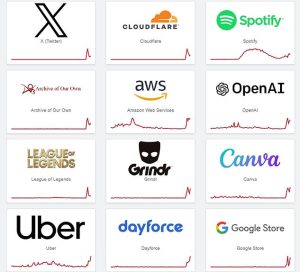Major Cloudflare Outage Cripples Global Internet Services
A massive Cloudflare outage on Tuesday morning brought down major websites and services worldwide, affecting platforms including X (formerly Twitter), ChatGPT, Spotify, Shopify, and critical infrastructure like New Jersey transit and French railways.
Key Takeaways
- Cloudflare outage affected 20% of global websites for nearly 6 hours
- Major platforms including X, ChatGPT, Spotify experienced downtime
- Company blamed “routine configuration change” for cascade failure
- Experts raise concerns about increasing vulnerability of internet infrastructure
Timeline of the Outage
The crisis began at 6:48 AM Eastern Time when Cloudflare’s systems started failing. Internet users worldwide experienced maddening connectivity issues as major platforms ground to a halt. By 9:42 AM, Cloudflare announced a fix had been implemented, with full service restoration by 12:44 PM.
Official Response and Apology
Dane Knecht, Cloudflare’s Chief Technology Officer, issued a groveling apology: “I won’t mince words: earlier today we failed our customers and the broader Internet. This caused real pain and the issue, impact it caused, and time to resolution is unacceptable.”
The company attributed the crash to a that “cascaded into a broad degradation to our network and other services.” They categorically stated this was not a cyber attack.
Expert Skepticism and Security Concerns
Despite official assurances, cybersecurity experts expressed skepticism. James Knight, senior principal at Digital Warfare with 30 years of cyber threat experience, told Daily Mail: “I’m very suspicious when I see something like this that doesn’t really smell right.”
Knight noted that major internet companies typically have extensive redundancy systems and multiple backups. He questioned how a routine update could bypass testing protocols and cause such widespread failure.
Cloudflare’s Critical Internet Role
Though not a household name, Cloudflare serves as the foundational infrastructure for 20% of global websites. The company operates as a “door” through which users access client websites like Uber, Zoom, and LinkedIn, routing traffic through 330 data centers worldwide to enhance speed and security.
This gatekeeper position makes Cloudflare a prime target for cyber attacks. In September, the company revealed it had thwarted the largest-ever DDoS attack, facing 11.5 terabytes-per-second of data – equivalent to downloading Netflix’s entire library every second.
Broader Pattern of Infrastructure Failures
The Cloudflare incident follows September’s Amazon Web Services blackout, which had a similar explanation about system updates causing crashes. Analytics firm CyberCube estimated the Amazon outage could cost $581 million.
Knight sees a concerning pattern: “We’ve got Cloudflare, where just one thing went wrong, and all of a sudden the whole system’s down.” He warned Americans to brace for further outages, suggesting this digital turmoil is far from over.







